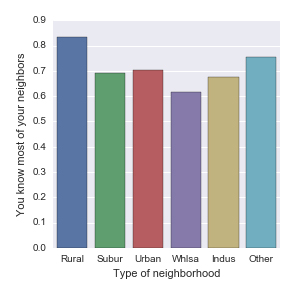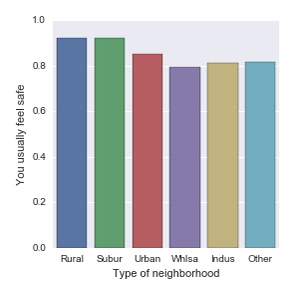Social capital in urban, suburban and rural settings
Research shows adults and communities benefit from social connections. Less is known about teenagers, and whether neighborhood features foster such social capital.
Studies tell us that where teens live can make a difference in their educational success, risky behaviors and social interactions. Also, youth spend a lot of time outside at a formative time in their development.
So, do urban, suburban and rural settings play a role in building social capital?
In a national survey of 6,504 adolescents, respondents were asked if they knew most of their neighbors. Turns out, suburban teens were most likely to say they did not.

However, not all social familiarity is the same. Gangs too have high social capital.
In the same survey, adolescents were asked if they usually feel safe in their neighborhood. It was suburban teens, and those in rural areas, who were most likely to say they felt safe.

To make it more interesting, I added a signal for outlook on life – grade point averages.
Suburban teens perform best in school, the same survey shows. And those likely to know most of their neighbors don’t do as well, while those who feel safest do better.
A key question, though, is whether these differences are statistically significant. For example, the range in grade averages is within a high B. That analysis comes next.
Also, a challenge with studies like this is how to define a neighborhood. Whether using physical boundaries, population densities, transportation options, etc., there’s no clear-cut answer. In this survey, the interviewers categorized respondents neighborhoods.
The data comes from the National Longitudinal Study of Adolescent Health, a school-based survey of youth in grades 7-12 in the U.S. I used Anaconda Python packages to prep the variables, and Seaborn to visualize results.
References:
- Boardman J.D., Saint Onge J.M. (2005). “Neighborhoods and adolescent development.” Children, Youth and Environments. 15: 138–164.
- Schaefer-McDaniel, Nicole J. (2004). “Conceptualizing Social Capital among Young People: Toward a New Theory.” Children, Youth and Environments. 14(1): 140-150.
- Sampson R.J., Morenoff J.D., Gannon-Rowley T. (2002). “Assessing ‘neighborhood Effects’: Social Processes and New Directions in Research.” Annual Review of Sociology. 28: 443-78.
- Sampson R.J., Raudenbush S.W. (1999). “Systematic Social Observation of Public Spaces: A New Look at Disorder in Urban Neighborhoods.” American Journal of Sociology. 105(3): 603-651.
- Sampson R.J., Raudenbush S.W., Felton E. (1997). “Neighborhoods and Violent Crime: A Multilevel Study of Collective Efficacy.” Science. 277(5328): 918-924.
- Litman T. (2014). “Community Cohesion As A Transport Planning Objective.” Victoria Transport Policy Institute.